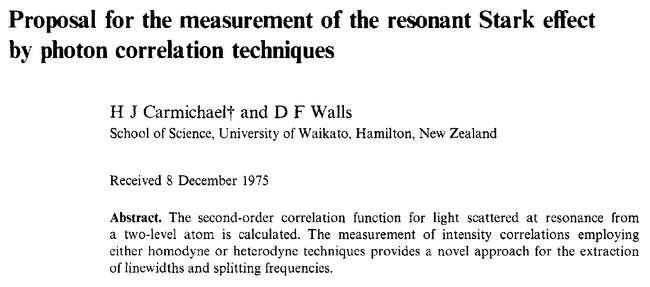The Authors propose to access the spectral features of the Mollow triplet from second-order statistics, specifically:

They obtain analytical results but in the stationary case only:
For a saturated atom this is stationary and we have managed an analytical calculation in this regime—Below Eq. (10).
They only quote Mollow's seminal paper[1] for a technical point and attribute the triplet to Schuda et al.[2]
They describe the onset for spectral splitting (Eq. (14)) as $\Omega_\sigma/\gamma_\sigma>1/8$ (Mollow triplet, overlooking the Mollow singlet $1/\sqrt{8}<\Omega_\sigma/\gamma_\sigma<1/8$).
The novelty with respect to their earlier paper[3] is unclear as the main idea of this one is already present («Let us now consider $G^{(2)}_\mathrm{ss}(\tau)$ from another perspective: that which sees in it a possible source for the experimental measurement of spectral parameters.») and this appears to be a condensed version of it.
References
- ↑ Power Spectrum of Light Scattered by Two-Level Systems. B. R. Mollow in Phys. Rev. 188:1969 (1969).
- ↑ Observation of the resonant Stark effect at optical frequencies. F. Schuda, C. R. Stroud Jr and M. Hercher in J. Phys. B.: At. Mol. Phys. 7:L198 (1974).
- ↑ A quantum-mechanical master equation treatment of the dynamical Stark effect. H. J. Carmichael and D. F. Walls in J. Phys. B.: At. Mol. Phys. 9:1199 (1976).
